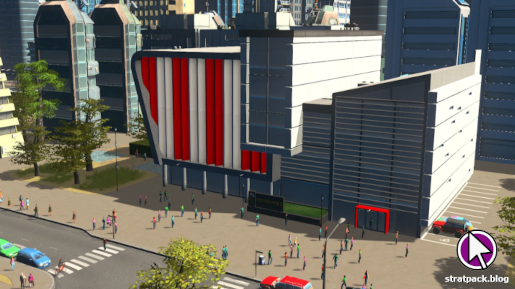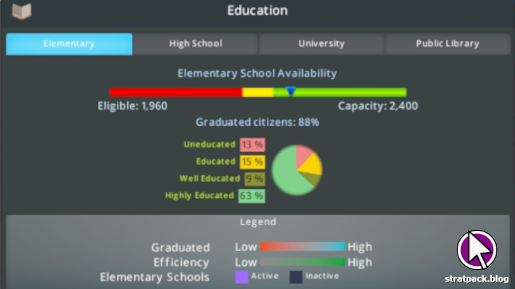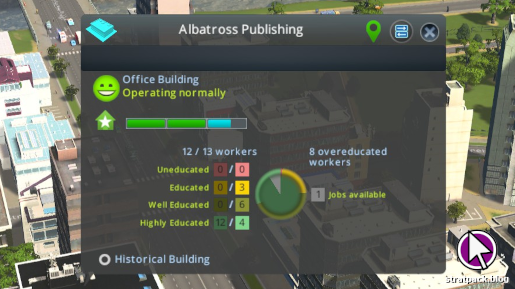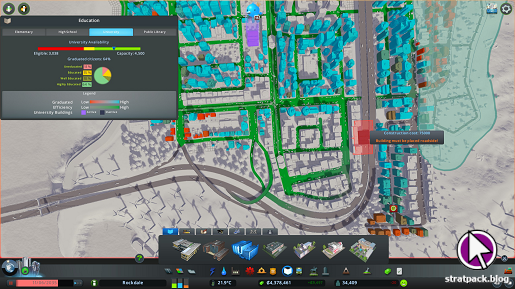
Cities: Skylines: A guide to schools, universities, and education
Planning and managing a growing city in Cities: Skylines is a lot like building a house of cards. Every individual element is connected, and they must all progress in unison, maintaining a careful balance. Once one part falls away - perhaps through a power cut or a health crisis, for example - it is very easy for everything to fall apart. Your city is constantly on the edge of chaos.

I recently jumped back into the game after a years-long hiatus, having splurged on a Humble Bundle with many of the expansions, and the problem I was met with concerned my citizens’ education. I didn’t want a sprawling industrial complex in my city, but the fancy office buildings that were popping up were complaining they didn’t have enough educated workers.
My subsequent investigation into the Cities: Skylines education system led to the article that follows, which attempts to explain how it all fits together.
Education levels
Cities: Skylines uses four levels to describe citizens’ education: uneducated, educated, well educated, and highly educated. These correspond to the most advanced educational institution that each citizen has graduated from.
• Citizens who have completed no education are uneducated.
• Citizens who have graduated from elementary school are educated.
• Citizens who have graduated from high school are well educated.
• Citizens who have graduated from university are highly educated.
It’s important to note that citizens must attend the relevant educational institution at the corresponding life stage - for example, a young adult who did not attend high school cannot then go to university. This means that as you develop your education system (which we’ll cover in a moment) it will take time for new youngsters to filter up through the ranks.

You can check on your citizens’ current education levels in a few different ways. First, you can see education levels for residents of a particular building by clicking on it. Most usefully, however, you can view a summary of the entire city’s education levels by clicking on the education icon on the toolbar and reviewing the pie chart in the pane that appears.
Why do we need educated citizens?
In short: Educating your citizens will help your city develop. This manifests in several different but interconnected ways across all three main zoning types.
At the simplest level, certain education standards are required for certain jobs. If you click a commercial or industrial building, you’ll see a summary of the jobs offered by level. If you don’t have enough educated workers, jobs at the higher end will go unfilled, either limiting that employer’s growth or - in the worst case scenario - even causing the business to fail.

But educated residents don’t just improve their workplaces - they also give their homes a boost. Residential blocks are more likely to level up when the people who live inside are better educated, assuming you’ve also put the work in to raise the land value far enough to make it possible. Interestingly, there’s also an in-game tip that says educated citizens produce less rubbish.
How to educate citizens
As you might expect, if you want to accelerate your citizens’ education then the first step is ensuring that the right schools and universities are available to them. Cities: Skylines has a US-style education system and you’ll want to build from the bottom up, making slow but steady progress.
An elementary school is the first stop for your young citizens. Then you’ll want to make sure they can secure a place at a high school (or institute of creative arts). Finally, well educated young adults can go to university (or a community college or modern technology institute) to take the final step and become highly educated model citizens ready for office jobs.

The first consideration when building this infrastructure is quantity. The tabs on the Education pane show the availablility of places at each institution, and you’ll want to make sure that their capacity is well clear of the number of eligible students to ensure that everybody who wants to can attend.
Accessibility is just as important. When you’re placing a building, the nearby roads will turn green to show which residences can easily attend, but you should also provide schools and universities with strong public transport links to enable citizens from further afield to make their way in, too.
Extra encouragement
If you put the above plan into action, you’ll see your citizens’ education levels increase dramatically over the next few generations, but there are also a few more changes you can make to give things a little extra push.
Firstly, the public library is an anomaly when it comes to educational buildings. Libraries mostly provide entertainment, but they do provide a very small educational boost for citizens, particularly at the lower end of the education hierarchy - just don’t expect overwhelming results.
The final weapons in your arsenal are education-related policies, which can be applied to either your entire city or to individual areas as required. Education Boost is your best friend here, providing a 25 percent budget increase and making citizens more likely to choose education over work. Educational Blimps is another winner, providing a small boost at no cost.
Needless to say, you should avoid some of the other policies. In particular, School’s Out will push citizens into work over university, and For-Profit Education will force them to pay to learn, to the exclusion of less well-off residents. So make sure these aren’t checked to avoid putting extra hurdles in the way of your citizens’ quest for knowledge.

















